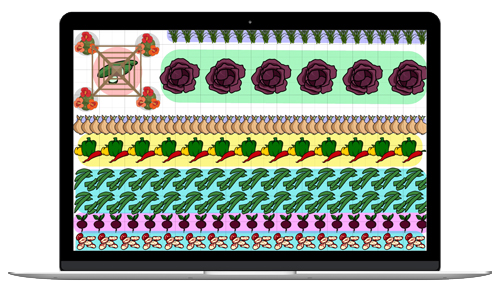
Blueberries are one of the easiest fruits to grow.
Planting, Growing, Pruning, and Harvesting Blueberries
The Almanac Garden Planner - Use It Free for 7 Days!
Plan your 2025 garden with our award-winning Garden Planner.
Blueberries are partially self-fertile, so you will harvest more and larger berries by planting two or more varieties together. Planting more than one variety can also extend the harvest season.
Highbush (Vaccinium corymbosum): A six-foot shrub hardy from Zone 4 to Zone 7.
- For withstanding cold winters, choose ‘Bluecrop’, ‘Blueray’, ‘Herbert’, ‘Jersey’, or ‘Meader’.
- For big berries, choose ‘Berkeley’, ‘Bluecrop’, ‘Blueray’, ‘Coville’, ‘Darrow’, or ‘Herbert’.
- For flavor, usually, the main reason for growing your own fruit, choose ‘Blueray’, ‘Darrow’, ‘Herbert’, ‘Ivanhoe’, ‘Pioneer’, ‘Stanley’, or ‘Wareham’.
- For something different, try ‘Pink Lemonade’, which produces bright pink blueberries!
Lowbush (Vaccinium angustifolium): For the coldest climates, lowbush varieties are your best bet, hardy from Zone 3 to Zone 7.
- These are the blueberries you find in cans on supermarket shelves. When fresh, the fruits are sweet and covered with a waxy bloom so thick that the berries appear sky blue or gray.
- The creeping plants, a foot or so high, are spread by underground stems, or rhizomes. They blanket the rocky upland soils of the Northeast and adjacent portions of Canada. Lowbush blueberries make a nice ornamental fruiting ground cover.
- Plants sold by nurseries are usually seedlings or unnamed wild plants rather than named varieties.
Half-High: Breeders have combined qualities of highbush and lowbush blueberries into hybrids known as half-high blueberries.
- The University of Minnesota introductions include ‘Northcountry’,v a variety that grows 18 to 24 inches high and has excellent, mild-flavored, slightly aromatic sky-blue fruits; and ‘Northblue’, which grows 20 to 30 inches high and produces an abundance of dark-blue, nickel-size, somewhat tart fruits-just right for pies.
- ‘Northland’ is a half-high that grows 3 to 4 feet tall. From Michigan, it has relatively bland, average-quality fruit.
Blueberries for Southern Gardens (Zones 7–9):
- Rabbiteye (Vaccinium virgatum): Grown in the southeastern United States, rabbiteye varieties are extremely adaptable, productive, and pest-tolerant. They do, however, have a high degree of self-incompatibility and require two or more varieties to be planted together to ensure pollination. Recommended varieties include ‘Powderblue’, ‘Woodard’, and ‘Brightwell’.
- Southern Highbush (hybrids of V. virgatum, V. corymbosum, or V. darrowii): Southern highbush varieties tend to be pickier and harder to grow than rabbiteyes, but there are a few high-quality varieties that do well. Among these are ‘Emerald’, ‘Windsor’, and ‘Springhigh’.
- Read more about blueberries for southern gardens from the University of Florida: Blueberry Gardener’s Guide.
ADVERTISEMENT
Is there a certain time of the day you should pick blueberries??? I’ve heard morning, that they sweeter!! Is the true? I want what’s best
Hi, Nicole,
You can pick blueberries in early in the morning after dew has evaporated, or after temperatures have cooled toward the end of the day as evening approaches. At these times, the berries may be firmer and store a little longer. Higher temperatures make berries softer, affecting quality; some blueberry varieties soften more quickly than others as the temperature goes up. After harvesting, keep berries cool.
Also, picking berries with dew or rainfall on them can affect quality—wait until the berries have dried.
Sweetness is more a factor of such things as the variety, growing conditions (such as enough sun, not too much moisture, enough soil nutrients, pH of around 4.0 to 5.0), and ripeness. For peak sweetness, wait 3 to 4 days after a blueberry turns blue to harvest it.
Hope this helps!
There are four types of blueberries: highbush, lowbush, hybrid half-high, and rabbiteye. We used to harvest lowbush Blueberries in the Maine wild. : )~
I have seen your post. It is very helpful for me. I came to know the benefits of Blueberry. Keep Posting these types of Posts. Thank you.
? were can I buy or get abluberry plants
They should be available at local garden centers—or there are a number of online retailers which may ship to you.
Hi, I planted 3 blueberry plants, one survived its first year pretty well. The other 2 the upper plant seemed to die, but i have growth coming from the roots. Is this still a live blueberry plant or is the root from some other type of plant? I have been letting them grow and they are getting bigger, however the leaves are definitely a different shape than the plant that lived.
Hi, Heather, If the leaf does not look like blueberry foliage, it doesn’t sound promising. You could let it grow for a while to confirm and/or bring the leaves to a local nursery and see if an expert there can identify it. As for the plants in general, we’ve found that improper soil, and in particular the soil’s pH, are often the problem. If you have not yet, you might want to do a soil test. Wishing you better luck next time!
Start with high-quality plants. This is the most important step in ensuring a successful crop of blueberries. Look for disease-resistant varieties that are well-suited to your climate zone.
I have small webbing on blue berry bush eats leAf then branch and kills it also on grant grey beard bush or smoke bush they cut top out of it














